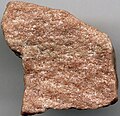File:Quartzite 1.jpg

Original file (836 × 811 pixels, file size: 1.2 MB, MIME type: image/jpeg)
| This is a file from the Wikimedia Commons. Information from its description page there is shown below. Commons is a freely licensed media file repository. You can help. |
Summary
| DescriptionQuartzite 1.jpg |
English: Quartzite (metaquartzite) (3.1 centimeters across at its widest)
Metamorphic rocks result from intense alteration of any previously existing rocks by heat and/or pressure and/or chemical change. This can happen as a result of regional metamorphism (large-scale tectonic events, such as continental collision or subduction), burial metamorphism (super-deep burial), contact metamorphism (by the heat & chemicals from nearby magma or lava), hydrothermal metamorphism (by superheated groundwater), shear metamorphism (in or near a fault zone), or shock metamorphism (by an impact event). Other categories include thermal metamorphism, kinetic metamorphism, and nuclear metamorphism. Many metamorphic rocks have a foliated texture, but some are crystalline or glassy. Quartzite is a common, crystalline-textured, intermediate- to high-grade metamorphic rock. It forms by metamorphism of quartzose sandstones or siltstones. Quartzite can be entirely composed of interlocking quartz crystals, or the original sand grains may still be visible. This rock is hard (H = 7), will not bubble in acid (unlike marble), and can be almost any color. The term “quartzite” has been used in geology to refer to crystalline, quartzose metamorphic rocks and to hard, well-cemented quartzose sandstones that have not been subjected to metamorphism. It is difficult to not call hard, well-cemented sandstones “quartzite” (for example, the Clinch Quartzite in the Appalachian Mountains & the Eureka Quartzite of the Great Basin in western USA). But the Clinch and Eureka aren’t metamorphic rocks. The term metaquartzite has been used by some geologists to refer to crystalline-textured, quartzose rocks that have been metamorphosed. This implies that “quartzite” be restricted to well-cemented, non-metamorphosed sandstones. I don’t often see the term metaquartzite used in the geologic literature. |
| Date | |
| Source | https://www.flickr.com/photos/47445767@N05/16887828502/ |
| Author | James St. John |
Licensing
- You are free:
- to share – to copy, distribute and transmit the work
- to remix – to adapt the work
- Under the following conditions:
- attribution – You must give appropriate credit, provide a link to the license, and indicate if changes were made. You may do so in any reasonable manner, but not in any way that suggests the licensor endorses you or your use.
| This image was originally posted to Flickr by James St. John at https://flickr.com/photos/47445767@N05/16887828502. It was reviewed on 7 August 2020 by FlickreviewR 2 and was confirmed to be licensed under the terms of the cc-by-2.0. |
7 August 2020
Captions
Items portrayed in this file
depicts
some value
21 March 2015
image/jpeg
File history
Click on a date/time to view the file as it appeared at that time.
| Date/Time | Thumbnail | Dimensions | User | Comment | |
|---|---|---|---|---|---|
| current | 02:41, 7 August 2020 |  | 836 × 811 (1.2 MB) | Ser Amantio di Nicolao | Uploaded a work by James St. John from https://www.flickr.com/photos/47445767@N05/16887828502/ with UploadWizard |
File usage
The following page uses this file:
Metadata
This file contains additional information, probably added from the digital camera or scanner used to create or digitize it.
If the file has been modified from its original state, some details may not fully reflect the modified file.
| Width | 876 px |
|---|---|
| Height | 847 px |
| Bits per component |
|
| Pixel composition | RGB |
| Orientation | Normal |
| Number of components | 3 |
| Horizontal resolution | 600 dpi |
| Vertical resolution | 600 dpi |
| Software used | Adobe Photoshop Elements 13.0 (Macintosh) |
| File change date and time | 23:12, 21 March 2015 |
| Exif version | 2.21 |
| Color space | sRGB |
| Unique ID of original document | 44C0117448E43EA0A446858E63E3AB52 |
| Date and time of digitizing | 19:05, 21 March 2015 |
| Date metadata was last modified | 19:12, 21 March 2015 |
